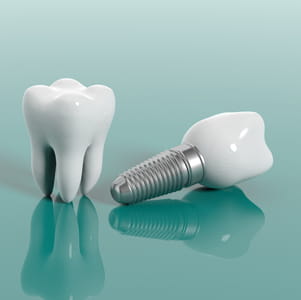
BACKGROUND: In a regular check-up with his dentist, Mr G expresses dissatisfaction with his upper partial denture. He asks about the possibility of a fixed solution to his missing upper teeth and is referred to a dentist – Dr L – specialising in implant treatment.
Dr L examines the patient and undertakes a panoramic radiograph. A treatment plan is proposed to place three dental implants in the upper jaw, with a single implant-retained crown at UR5 and a three-unit bridge from implants at UL3 and UL5. The dentist notes the need for bone augmentation and also records that Mr G has a cross bite on his posterior teeth and an edge-to-edge occlusal relationship on his anterior teeth.
Three weeks later the procedure is undertaken, with the bony ridge surgically split and augmented to facilitate implant placement. A few months later Dr L records that the restoration has been completed as planned and Mr G is happy with the result.
Mr G attends his regular dentist – Mr J – for a check-up and hygienist appointment. He states that he is not entirely happy with the fit and appearance of the implant-retained bridge. The dentist notes inflammation buccally and deposits around the bridge, with significant inflammation and bleeding. He questions whether excess cement is present.
Mr J writes to Dr L requesting that he arrange to see the patient again to address these problems but a month later Mr G returns to the practice complaining now that the implant at UR5 feels “loose”. The patient has also not heard back from Dr L. That afternoon Mr J phones Dr L and an appointment is arranged for the next day.
Dr L agrees both that UR5 is mobile and the upper left bridge needs redesigned to improve appearance and ease of home care. He plans to replace the UR5 implant and ease the bite on the upper right side to avoid heavy contact and allow implant integration.
This work is undertaken at no additional cost but over the next year Mr G has persisting problems with mobility in UR5 and fit in the upper left bridge with caries now in adjoining teeth. The patient loses confidence in Dr L and Mr J refers him to another implant dentist to carry out further remedial treatment.
Four months later Dr L receives a letter of claim from solicitors acting on behalf of Mr G. It alleges failure to properly assess the ridge profile and need for significant bone grafting to ensure implant success in both the upper right and left quadrants. Consideration should have been given to the potential for occlusal overload in the upper right quadrant given the patient’s unusual bilateral posterior crossbite and edge-to-edge relationship anteriorly. The claim also alleges failure to provide a well-fitted bridge in the upper-left quadrant, with excess cement and a lack of adaptation to soft tissues.
ANALYSIS/OUTCOME: MDDUS acting on behalf of Dr L commissions an expert report from a restorative specialist with experience in placing implants. In regard to the assessment and treatment plan, the expert notes that Dr L did take a panoramic radiograph to assess alveolar bone height and, in combination with clinical examination, concluded that bone augmentation was necessary. In the surgical treatment the bony ridge was split and augmented without incident and postoperative radiographs were taken.
The expert further observes that although the initial bridge was not a good shape to make cleaning easy Dr L did provide a replacement, but he finds the initial excess cement and inadequate adaptation to soft tissues indefensible. In regard to the implant failure at UR5, the expert judges that the occlusal relationship was particularly critical to success, especially with the narrow ridge requiring splitting and augmentation. He concludes that it would be difficult to defend Dr L for not taking this factor adequately into account.
MDDUS in agreement with the member negotiates a settlement based primarily on the cost of further remedial treatment.
KEY POINTS
- Ensure that all factors impacting treatment success are considered and communicated to the patient.
- Dental implant restorations often come with higher aesthetic demands and satisfying these in all patients can be difficult.
This page was correct at the time of publication. Any guidance is intended as general guidance for members only. If you are a member and need specific advice relating to your own circumstances, please contact one of our advisers.
Save this article
Save this article to a list of favourite articles which members can access in their account.
Save to library